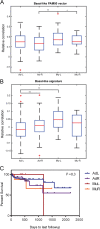Phenotypic characteristics of colorectal cancer in BRCA1/2 mutation carriers
- PMID: 29321669
- PMCID: PMC5839043
- DOI: 10.1038/s41431-017-0067-1
Phenotypic characteristics of colorectal cancer in BRCA1/2 mutation carriers
Abstract
Mutations in the BRCA1/2 genes were recently shown to be associated with an increased risk for colorectal cancer. We characterized the largest cohort available of BRCA1/2 mutation carriers with colorectal cancer. We analyzed 32 patients with lower gastrointestinal cancers and germline BRCA1/2 mutations from two large academic hospital registries; 91% of patients were of Ashkenazi ancestry, 78% were women, and 62.5% were carriers of BRCA1 gene mutations. A high percentage of colorectal tumors (34.5%) had a mucinous histology and were located atypically in the left colon. Two patients had anal cancer with unusual histology and an additional patient had mucinous small bowel carcinoma. Gene expression analysis showed significant correlation between the gene signatures of left mucinous colorectal cancer and basal-like breast cancer. Our results imply that Ashkenazi BRCA1/2 mutation carriers with colorectal cancer might have unique characteristics with a high rate of left-sided, mucinous histology colorectal cancer, and possibly anal carcinoma. This report suggests a phenotypic influence of defects in DNA repair genes on colorectal tumors.
Conflict of interest statement
The authors declare that they have no conflict of interest.
Figures

References
MeSH terms
Substances
LinkOut - more resources
Full Text Sources
Other Literature Sources
Medical
Miscellaneous

